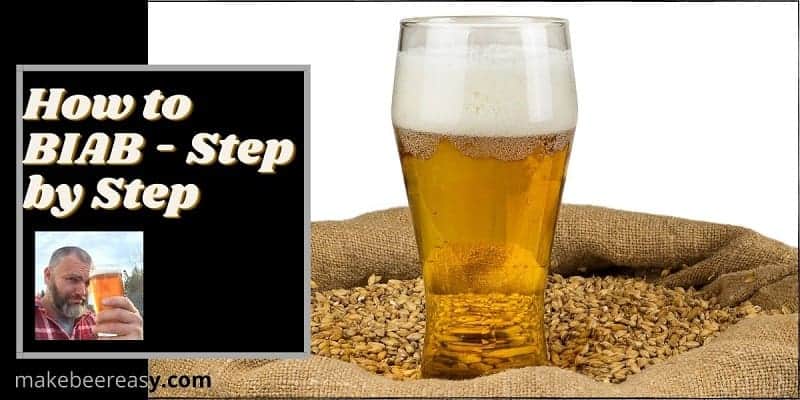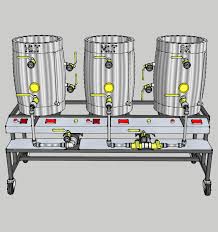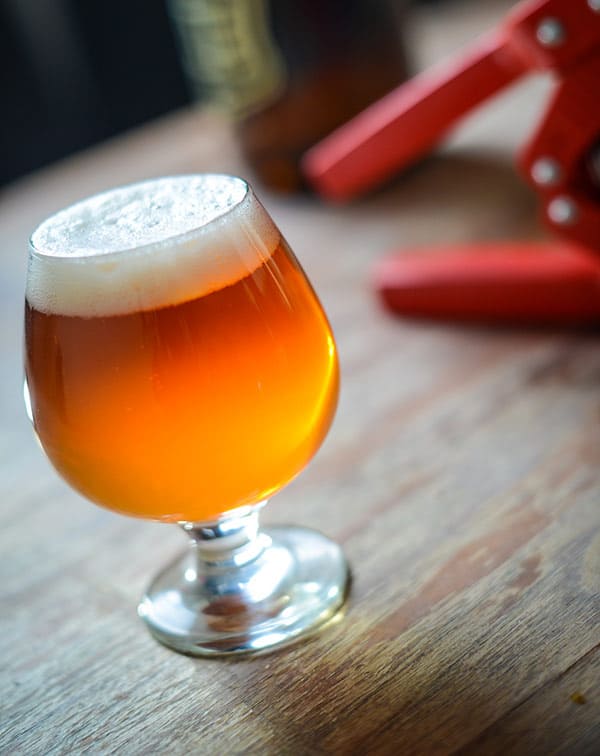BIAB or Brew in a Bag is a style of home brewing that is simple to do, inexpensive to get started with and makes delicious beer. For these reasons it is the method I recommend homebrewers who want to get into making all grain beer start with. In this post you will find all of the steps required when learning how to BIAB to include:
- The steps involved in a BIAB brew day
- The equipment you need
- Where to find BIAB recipes
So let’s get to it…
What Exactly is BIAB
My gut is that if you are looking for how to biab then you already have at least a pretty good idea what the basics of it are.
For those of you who do not know BIAB stands for Brew in a Bag. Basically it is a simplified all grain brewing method designed by some of my favorite people on this planet i.e The Australians! 
These genius people took what I believe was an over complicated process (all grain brewing) and dummied it down for those of us who wanted a simplified way of home brewing our own all grain beer.
Whereas some of the older more traditional methods of making beer use 3 vessels to include a hot liquor tank, a mash tun and a boil kettle but with BIAB brewing you use only 1 vessel and a brew bag!
This means that your brew day is much easier, a lot shorter, there is less hassle involved and the clean up is a breeze in comparison to the tradtional all grain brewing methods. And the best part is that the cost to get set up is a fraction of the price.
How 3 Vessel Brewing Works
In order to understand how brew in a bag works I will quickly run you through how a traditional 3 vessel brew day would go.
1) First you would heat up your mash water in the hot liquor tank.

2) Once you have reached your strike temperature you would transfer the mash water from the hot liquor tank to the mash tun.
3) You would dough in. (Add your grains to the mash tun).
4) You would do your 60-90 minute mash in the mash tun.
5) Once you were done mashing and sparging you would transfer the wort over to the boil kettle.
6) You would boil the wort, adding hops at the intervals outlined in your recipe.
7) Once boil is over you would chill the wort, add to the fermenter, pitch your yeast.
That is a high elevated overview of a brew day, but you get the idea.
How BIAB Works
With BIAB brewing you only have the one vessel/kettle… it serves as the hot liquor tank, the mash tun (with the bag), and the boil kettle.
1) Heat up the water to strike temperature in your 1 vessel/kettle.

2) Put the brew bag in the kettle once temperature is reached.
3) Fill up the bag with your grains.
4) Mash which is done by leaving the bag filled with the grains in the kettle and keeping the water at your mash temp. The BIAB mash time is the same as any other brewing method.
5) Pull grain bag out of the kettle once mash is over. Let the liquid drain into kettle from bag.
6) You can now do a rinse sparge if you like. In order to get the volume of liquid up to your pre boil level simply pour warm water over the grain bag, rinsing the sugars that are still left down into the liquid wort. Water should be around 170 degrees Fahrenheit.
7) Boil the liquid which is now called wort, adding hops as your recipe calls for them.
8) Chill the wort, add it to the fermenter and add your yeast (pitch the yeast).
That’s it, same basic idea as brewing in a 3 vessel system but so much easier and less convoluted and makes just as delcious homebrew.
Next time you see an Australian thank them! 🙂
Equipment You Need
Besides the ease of cleaning up after brew day in my opinion this is the next best part of BIAB brewing. The equipment requirement is very minimal especially if you were already brewing beer with malt extract.
The following is the equipment you need:
1) A kettle. If you are brewing 5-6 gallon batches, get one that can hold 15 gallons.
2) A turkey fryer and a bottle of propane (you brew outside with this system. I you want to brew inside you can get an all-in-one brewing system, which is basically brew in a bag but an electric version, I use both).
3) A brew bag. Make sure the bag you pick up is the right size for your kettle.
4) A mash paddle (AKA a big metal or plastic spoon).
Outside of that you will use your fermenting equipment you used for brewing beer kits. If you have never brewed at all I recommend you read the following post as this article is written with the understanding that you have at least made beer using malt extract beer kits.
And the following link will take you to a very thourough overview all of the Equipment, Ingredients and the Recipes you will need to make a beer this way.
=> Equipment You Need for Brewing in a Bag
BIAB Recipes
As for recipes… you can use an all grain recipe and it will work just fine.
One of the simplest ways to get started though is to use an all grain beer kit. These kits come with the recipe and all the ingredients all packaged up for you.
This saves you from having to find your own recipe and source out all of your own ingredients.
I love using these all grain beer kits. To this day I still use many of the recipes that came with those kits because they make some very nice beer.
I have put together a post reviewing my top 5 favorite online vendors, all of them sell good all grain beer kits you can use to brew using your BIAB system. You can check them out here.
Time to Brew
When it comes to learning how to biab that is as hard at it really is my friend. I am here to help you if you any questions or need further help.
The following are two other posts that you may find help with getting started with brew in a bag:
Let me know in the comments if you found this post helpful or if you have any questions on getting going.
Now go get your brew awnnn…
Cheers Big Robb is Out!


How do you determine your starting water volume with the AIH kits?
Hey Josh it is going to depend on your system and your boil off rate. They are 5 gallon finished. Pr-boil probably somewhere between 6.25-6.5 gallons, but again depending on your system. If your system boils off 1 gallon in an hour, and you want to stop the boil at 5.25 gallons (to account for sediment/trub) then pre boil would be 6.25 gallons. You can always do a test of your system with water, boil it for an hour and see how much you boiled off. Trust that helps. Cheers